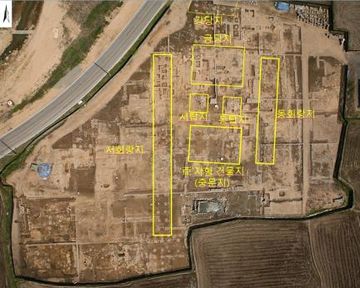"경주 인왕동 사지"의 두 판 사이의 차이
(→영문) |
|||
| 31번째 줄: | 31번째 줄: | ||
===영문=== | ===영문=== | ||
'''Temple Site in Inwang-dong, Gyeongju''' | '''Temple Site in Inwang-dong, Gyeongju''' | ||
| + | |||
| + | This is the former site of the temple, which is presumed to have been built in the 7th century, during Unified Silla period (668-935). | ||
| + | |||
| + | Japanese researchers, who investigated this place during the Japanese colonial period (1910-1945) suggested that this was Inyongsa, a temple appearing in Memorabilia of the Three Kingdoms (Samguk yusa). Inyongsa was built to pray for a blissful afterlife for Gim In-mun (629-694), the second son of King Muyeol. This was the first temple, which was built to pray for an individual, not a king or a monk. | ||
| + | |||
| + | After Silla created a coalition with Tang China (618-907), Tang China tried to conquer Silla and imprisoned Gim In-mun, who went to Tang in 671. A temple was constructed to pray for his return, but after he died in 694 while coming back to Silla, the proposed prayer was changed to a prayer for blissful afterlife for him. | ||
| + | |||
| + | During excavations that were conducted four times from 2002 to 2011, remains of a central gate, a pagoda, a main worship hall, a lecture hall, a lotus pond, a well, and others were found. A central gate, a main worship hall and a lecture hall create a straight line, and two pagodas in front of a main worship hall is typical of Unified Silla temples. | ||
===영문 해설 내용=== | ===영문 해설 내용=== | ||
2020년 6월 23일 (화) 10:53 판
| 경주 인왕동 사지 Temple Site in Inwang-dong, Gyeongju |
|
 경주 인왕동 사지, 국가문화유산포털, 문화재청. |
|
| 대표명칭 | 경주 인왕동 사지 |
|---|---|
| 영문명칭 | Temple Site in Inwang-dong, Gyeongju |
| 한자 | 慶州 仁旺洞 寺址 |
| 주소 | 경상북도 경주시 인왕동 341-3 |
| 지정번호 | 사적 제533호 |
| 지정일 | 2016년 1월 28일 |
| 분류 | 유적건조물/종교신앙/불교/사찰 |
| 시대 | 통일신라 |
| 수량/면적 | 16필지 35,282㎡ |
| 웹사이트 | 경주 인왕동 사지, 국가문화유산포털, 문화재청. |
|
|
|
해설문
국문
일제강점기 일본인 학자들이 인용사(仁容寺)의 터로 추정하였다. 『삼국유사』에 인용사는 태종무열왕의 둘째 아들인 김인문(金仁問, 629~694)의 안녕을 비는 절이었다.
고구려 멸망 이후 당나라는 신라까지 정벌하려 하였다. 이때 당에 머물고 있던 김인문을 감옥에 가두었다. 신라 사람들은 그의 귀국을 기원하며 관음도량(觀音道場)을 열었으나, 효소왕 3년(694)에 김인문이 귀국하던 중에 죽자 미타도량(彌陀道場)으로 바꾸었다. 인용사는 신라에서 승려나 왕이 아닌 개인을 위해 세운 최초의 사찰로서 당시의 신앙 형태를 보여준다.
2002~2011년까지 국립경주문화재연구소가 4차례에 걸쳐 발굴 조사하였다. 신라의 전형적인 쌍탑식 가람배치로 유례가 드문 아[亞]자형 건물지를 비롯 탑지, 금당지, 강당지, 회랑지, 연지와 우물 등을 확인하였다.
영문
Temple Site in Inwang-dong, Gyeongju
This is the former site of the temple, which is presumed to have been built in the 7th century, during Unified Silla period (668-935).
Japanese researchers, who investigated this place during the Japanese colonial period (1910-1945) suggested that this was Inyongsa, a temple appearing in Memorabilia of the Three Kingdoms (Samguk yusa). Inyongsa was built to pray for a blissful afterlife for Gim In-mun (629-694), the second son of King Muyeol. This was the first temple, which was built to pray for an individual, not a king or a monk.
After Silla created a coalition with Tang China (618-907), Tang China tried to conquer Silla and imprisoned Gim In-mun, who went to Tang in 671. A temple was constructed to pray for his return, but after he died in 694 while coming back to Silla, the proposed prayer was changed to a prayer for blissful afterlife for him.
During excavations that were conducted four times from 2002 to 2011, remains of a central gate, a pagoda, a main worship hall, a lecture hall, a lotus pond, a well, and others were found. A central gate, a main worship hall and a lecture hall create a straight line, and two pagodas in front of a main worship hall is typical of Unified Silla temples.
영문 해설 내용
이곳은 통일신라시대인 7세기 말에 지어진 것으로 추정되는 절의 옛 터이다.
일제강점기에 이곳을 조사한 일본인 학자들은 이곳이 『삼국유사』에 등장하는 인용사가 있던 곳이라고 추정하였다. 인용사는 태종무열왕(재위 654-661)의 둘째 아들인 김인문(629-694)의 명복을 빌기 위해 지어졌으며, 신라에서 승려나 왕이 아닌 개인을 위해 세워진 최초의 사찰이었다.
신라가 당나라와 연합하여 삼국을 통일한 이후, 당나라는 신라를 정벌하려 하였고 671년 당에 머물고 있던 김인문을 감옥에 가두었다. 신라에서 김인문의 무사귀환을 기원하며 사찰을 창건하였으나, 694년 그가 귀국하던 중에 죽자 이곳에서 그의 명복을 빌기 시작하였다고 한다.
2002년부터 2011년까지 4차례에 걸쳐 발굴조사가 이루어졌고, 중문지, 탑지, 금당지, 강당지, 회랑지, 연지, 우물 등이 확인되었다. 중문, 금당, 강당이 일직선상에 배치되고, 금당 앞에는 쌍탑이 세워진 통일신라시대의 전형적인 가람 배치이다.
참고자료
- 문화재청 공식 블로그 https://blog.naver.com/chagov/220693425655